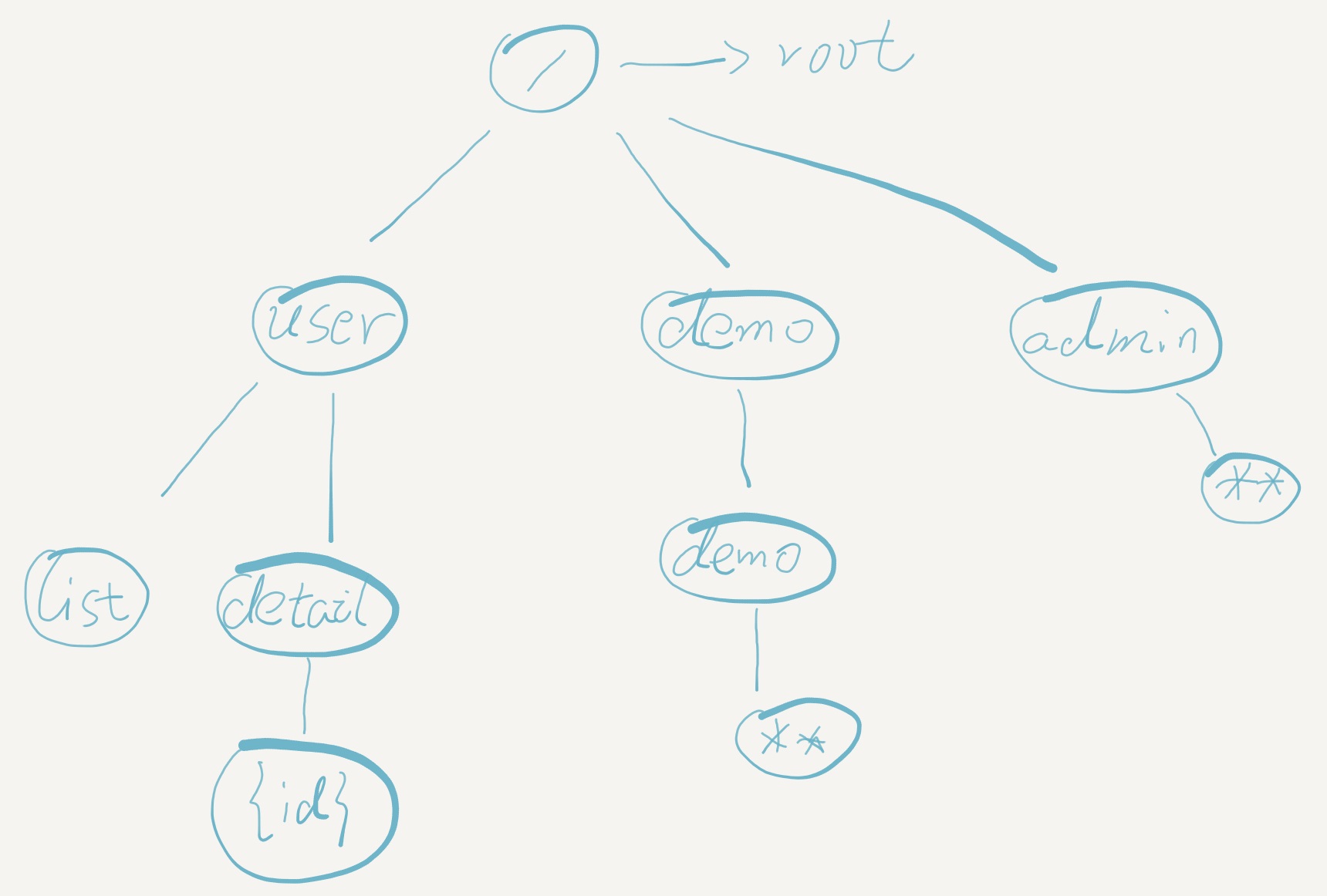使用特里树匹配动态路由
Updated:
使用特里树匹配动态路由
问题
在使用网关(gateway)进行URL权限匹配的时候,需要根据客户端请求的URL进行路由匹配,然后进行权限校验;
参考:微服务统一认证鉴权
一般的网关会把URL与权限对应关系存在数据库,类似这样:
| NAME | URL | ROLES |
|---|---|---|
| 用户管理 | /user/list | USER |
| 用户管理 | /user/detail/{id} | USER |
| 资源管理 | /demo/demo/** | USER |
| 管理员 | /admin/** | ADMIN |
然后将权限数据加载进内存,根据每次请求时,匹配路由和权限,来决定是否放行;
//创建权限字典:
Map<String, List<String>> paths = new HashMap<>();
paths.put("/user/list", Arrays.asList("USER", "ADMIN"));
paths.put("/user/detail/{id}", Arrays.asList("USER", "ADMIN"));
paths.put("/demo/demo/**", Arrays.asList("ADMIN"));
paths.put("/admin/**", Arrays.asList("ADMIN"));
Set<String> auths = new HashSet<>();
//路由匹配:
AntPathMatcher pathMatcher = new AntPathMatcher();
String path = exchange.getRequest().getURI().getPath();
//遍历权限字典,进行匹配:
paths.forEach((k, v) -> {
String pattern = k;
if (pathMatcher.match(pattern, path)) {
auths.addAll(v);
}
});
但是每次调用,都需要遍历所有的权限字典数据;时间复杂度为:n,n为URL总数;
所以,当网关配置的URL很多时,效率肯定不行;
解决思路
考虑使用特里树(Trie Tree)进行路由匹配;
特里树,是类似下图的一种数据结构:

- 将字符串重复的前缀部分,作为树结构的父节点;
- 在进行路由匹配时,根据URL中的斜杠进行分割;然后根据每个分段与特里树的节点进行匹配;一级一级向下匹配即可;
- 时间复杂度为:URL的斜杠的个数,也就是类似文件夹的层级;时间复杂度基本为常数;
一些路由规则:
/user/logout/user/list这种路由作为静态路由;/user/{id}这种路由作为动态路由;一般只允许有一个动态路由;/admin/**这种路由则作为通配符路由;通配符路由一般也是只有一个;
示例代码
以下是Java示例代码:
//子节点
private class Node {
private String path;
private String segment;
private Map<String, Node> staticRouters;
private Node dynamicRouter;
private boolean isWildcard; //是否是通配符路由
}
public class Router {
private Node root;
public Router() {
root = new Node();
root.path = "/";
root.segment = "/";
}
//新增路由
public Router addRoute(String path) {
if (!StringUtils.isEmpty(path)) {
String strippedPath = StringUtils.strip(path, "/");
String[] strings = StringUtils.split(strippedPath, "/");
if (strings.length != 0) {
Node node = root;
//按照斜杠分割:
for (int i = 0; i < strings.length; i++) {
String segment = strings[i];
//添加节点:
node = addNode(node, segment);
if ("**".equals(segment))
break;
}
//结束时,设置子节点的path:
node.path = path;
}
}
return this;
}
//添加节点:
private Node addNode(Node node, String segment) {
//如果是通配符节点,直接返回当前节点:
if ("**".equals(segment)) {
node.isWildcard = true;
return node;
}
//如果是动态路由,则创建一个子节点,然后将子节点挂在当前节点下:
if (segment.startsWith("{") && segment.endsWith("}")) {
Node childNode = new Node();
childNode.segment = segment;
node.dynamicRouter = childNode;
return childNode;
}
Node childNode;
//静态路由,放到一个Map里,map的key为URL分段,value为新的子节点:
if (node.staticRouters == null)
node.staticRouters = new HashMap<>();
if (node.staticRouters.containsKey(segment))
childNode = node.staticRouters.get(segment);
else {
childNode = new Node();
childNode.segment = segment;
node.dynamicRouter = childNode;
node.staticRouters.put(segment, childNode);
}
return childNode;
}
//匹配路由:
public String matchRoute(String path) {
if (!StringUtils.isEmpty(path)) {
String strippedPath = StringUtils.strip(path, "/");
String[] strings = StringUtils.split(strippedPath, "/");
if (strings.length != 0) {
Node node = root;
//按照斜杠分割:
for (int i = 0; i < strings.length; i++) {
String segment = strings[i];
node = matchNode(node, segment);
//如果没有匹配到,或者是通配符路由,退出:
if (node == null || node.isWildcard)
break;
}
if (node != null)
return node.path;
}
}
return null;
}
//匹配子节点:
private Node matchNode(Node node, String segment) {
if (node.staticRouters != null && node.staticRouters.containsKey(segment)) {
return node.staticRouters.get(segment);
}
if (node.dynamicRouter != null)
return node.dynamicRouter;
if (node.isWildcard)
return node;
return null;
}
}
使用示例:
Router router = new Router();
router.addRoute("/user/**");
router.addRoute("/user");
router.addRoute("/user/{userId}");
router.addRoute("/equipment/**");
router.addRoute("/user/bg/**");
System.out.println("OK");
String route = router.matchRoute("/user/bg/**");
System.out.println(route);
route = router.matchRoute("/user/123");
System.out.println(route);
route = router.matchRoute("/user");
System.out.println(route);
其他
一些细节问题,比如,多个动态路由、单星号的通配符等,没有优化;有需要时再优化吧。
参考
参考链接:
